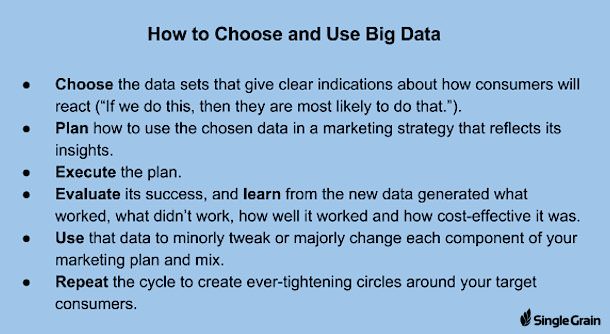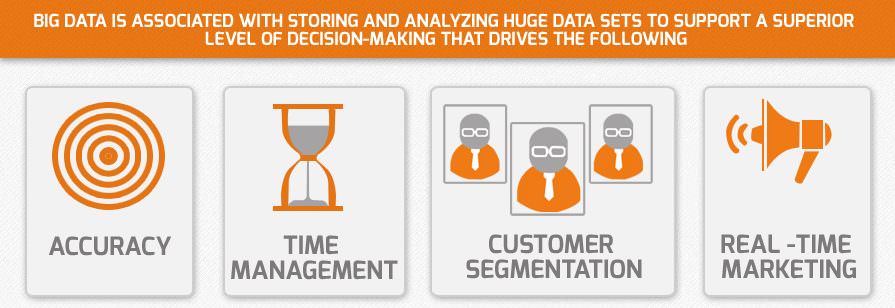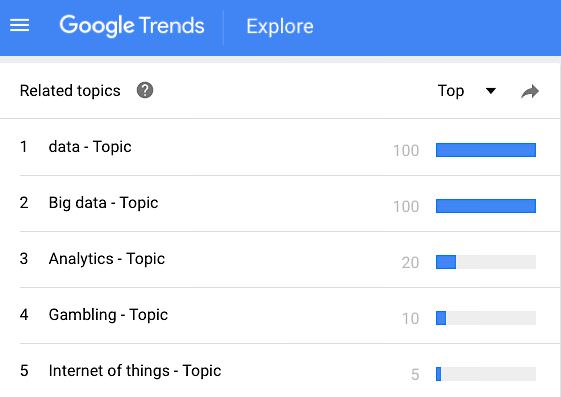If you had a dollar for every time you heard a marketing professional say “We’re using big data to improve our marketing,” you’d be retired in your beachfront property right now instead of reading this, right?
Everyone is “using big data” for marketing purposes.

But many are spending money and getting little profit in return because they’re either still ascending the learning curve or they’ve avoided what seems to be an overwhelming challenge: getting a grip on big data analytics.
As Inside Big Data says, “The acquisition and analysis of data and its subsequent transformation into actionable insight is a complex workflow.”
But let me reassure you: Marketing analytics that use massive data sets have proven effective when properly understood and employed, as discussed below. If you remain skeptical, read on as we make the case.
Proper Big Data Marketing Analytics
These bedrock goals won’t surprise you:
- Understanding your customers well enough to predict which products and services they want as well as what marketing methods will be effective with them
- Analyzing your marketing return on investment (MROI) to quantify the effectiveness of each technique
These goals can be achieved more accurately than ever when big data informs the analysis. According to McKinsey & Company, one U.S. insurance provider used big data analytics to achieve marketing productivity growth of at least 15% per year for four years in a row while maintaining a flat marketing budget. The company’s CMO said, “Marketing analytics have allowed us to make every decision that we made before better.”
Learn More: Why Digital Marketing Analytics Matter To Your Business
With all the anecdotal evidence out there, you would think that hard data in the age of big data would be readily available. But for these several reasons, it’s scarce:
- Big data-driven marketing is fairly new and evolving rapidly, so numbers from one or two years ago might not be relevant anyway.
- There are infinite ways to apply big data analytics to marketing and everyone does it differently, so empirical data is too diverse to be of uniform use.
- Company marketers that have success are tight-lipped about the “how-to” of their approach, and marketing agencies that have success keep their effective strategies between them and their clients.
What we’ve done here is bring together the best practices of using big data to inform marketing.
As JPMorgan Chase VP Mousumi Ghosh puts it, let’s look at the “capabilities and competencies associated with storing and analyzing huge data sets to support a level of decision-making that is more accurate and timely than anything previously attempted.”
How to Choose and Use Big Data
There are two truths. One, an immense amount of data is available. And two, it is not of equal value.

The successful marketing pro chooses what data matters and uses it effectively.
Whether or not the use is effective is evidenced by results. Empirical evidence for the success rates of all marketers using all data in developing all strategies with an examination of all results isn’t currently possible and never will be because companies aren’t going to make their data public.
However, refining results data about what you choose, how you use it and what ROI it brings is certainly possible and, in fact, essential to your success.
In short, your goal is turning the right data sets into marketing actions that are analyzed for effectiveness and then improved.
The cycle is:

What Data Matters
This is the first part of the “choose + use + evaluate = results” equation. It’s the premise that will produce profitable conclusions if you get it right. In these three categories, big data matters:
- Who: Who is your current customer? What are the metrics regarding browsing behavior, e-mails opened, click-through rates, social media engagement, location, response to loyalty programs and coupon offers, involvement in your online community, blog readership and purchases? This is pure marketing data, but two other data types must be engaged.
- How: How have you marketed to your “Who” and what were the results for their overall engagement and purchasing behavior?
- How much: What is the cost vs. return of your marketing efforts? The bean counting is a necessity, showing marketing expenditure, sales, gross income, net profit and other metrics that gauge MROI.
Using the Right Data Effectively
These are current best practices for marketing that is informed by big data.
1. Make Analysis-based Marketing Decisions
That’s what we’ve been discussing, of course, but it’s amazing how often marketing strategies are still “beauty contests” that, as McKinsey & Company says, “reward the coolest proposal or the department that shouts the loudest rather than the area that most needs to grow or defend its current position.”
The person with which the marketing buck stops must demand analytic evidence that a marketing strategy will meet MROI goals in an acceptable time frame. The evidential data is available to be mined.
Learn More: 5 Ways to Track Your Website’s Revenue with Google Analytics
2. Track and Respond to Changing Consumer Behavior
Consumer behavior evolves consistently in ways that have been well tracked, such as:
- Trending away from print and to digital and away from text to video
- Reading online reviews as part of the decisioning process
- The rise of mobile
- The influence of social media on buying decisions
- The importance of influencer marketing (peers/authorities count more than ads)
- A preference for browsing product information on retailers’ sites rather than on manufacturers’ sites
- The move away from conspicuously branded products, especially among millennials who don’t want to pay to be an Abercrombie and Fitch or Apple billboard
Ghosh recommends paying attention to the minutiae, because that’s where sales are often made:
“Modern marketers should shed light on a more granular level of detail, such as: which websites a user frequents most often, which social media profiles they have and use, and even which buttons they click on a given website. The ‘ideal customer profiles’ can easily be targeted with the big data.”
The better you understand your potential customers and show up where they are searching or hanging out, the higher your MROI will be.
3. Compare Your Perception to Reality and Adjust
Your current customer profile might show differences from your target audience. In other words, who you thought would gravitate to your products and services might be slightly different from who actually does buy. There will be overlap, unless you grossly misjudged the appeal of what you sell.
This presents a two-fold opportunity: Give your actual customers more of what they want AND expand your offerings to appeal to your original target group. Never overlook the “both/and” option.

4. Engage Your Target Consumer on Their Terms
The data will tell you where to find your ideal consumer, such as social media channels, news, entertainment or review sites. It tells you what they want by what they’re browsing or reading reviews about. You’ll learn how they prefer to be contacted, when the best time to contact them is and which marketing outreach is likely to be most influential.
Google Trends is a shortcut to some of this information. It delivers a wealth of information about hot keyword searches by region and what’s popular among demographics important to your business.

Once you’ve earned consumers’ business, keep them loyal by giving them what they want: rewards, new product offerings, the opportunity to have questions answered or to give input or the freedom to be left alone. By giving them what they want, you will be rewarded with their repeat business when they’re ready to buy.
Don’t make the mistake of thinking they all want the same thing. The more specific you can cost-effectively be, the better MROI you’ll realize.
Related Content: How E-commerce Companies Can Drive Sales with Facebook Messenger Chatbots
5. Try Tools, Master the Best
Not all software systems are equal or ideal for your niche or industry. Find the best of these:
- CRM tools: Customer relationship management software for communication with consumers, managing those relationships, tracking engagement, measuring campaign success rates with the goal of strengthening the relationship and maximizing the lifetime sales to each customer. Marketing automation software overlaps with CRM but is worth looking at as a separate tool, too.
- Social media tools: Quality social media software automates your social media outreach across all the channels you want to be on and tracks its effectiveness for each. This time-saving tool is a brand builder and profit maker when used effectively.
- Analytics tools: Making sense of the data is the only way to use it profitably. Analytics software that provides you with detailed reports are useful for evaluating your past and informing your future marketing strategies is indispensable.
Give Them What They Want
Respectfully cultivating or enhancing consumer desire and then giving consumers what they want is a marketing strategy that has stood the test of time. Not only does it still work, but it’s now possible to apply it with more individualized precision than ever before.
Charles Payne of the Fox Business Network joked recently that Amazon is getting so good at marketing analytics, the company will soon be shipping you stuff you didn’t order. You’ll say, “Wait, I didn’t order this, but wow, it’s exactly what I want! I’ll keep it!”
We’re not there yet, and there are ethical and business concerns with such an approach. However, the facetious scenario points out exactly what you’re trying to do – anticipate what consumers want, nudge them towards it and put the product or service in front of them when and where they are most likely to purchase it.
That’s how to grow marketing ROI with smart big data analytics.
